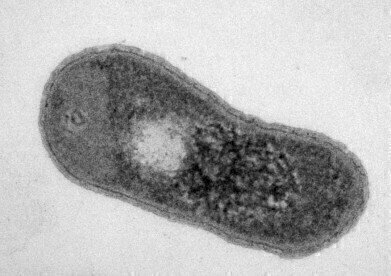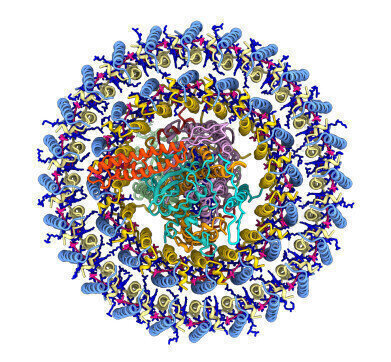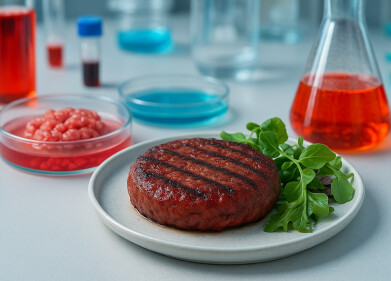-
 Swan lake in northern China where the bacterium Gemmatimonas phototrophica was collected (courtesy: Professor Fuying Feng)
Swan lake in northern China where the bacterium Gemmatimonas phototrophica was collected (courtesy: Professor Fuying Feng) -
 TEM image of Bacterium Gemmatimonas phototrophica – (courtesy: Jason Dean BSc. from the Institute of Microbiology, Czech Academy of Sciences, Trebon)
TEM image of Bacterium Gemmatimonas phototrophica – (courtesy: Jason Dean BSc. from the Institute of Microbiology, Czech Academy of Sciences, Trebon) -
 Photosynthetic complex from bacterium Gemmatimonas phototrophica – (courtesy: Dr. Tristan I. Croll, University of Cambridge, UK)
Photosynthetic complex from bacterium Gemmatimonas phototrophica – (courtesy: Dr. Tristan I. Croll, University of Cambridge, UK)
News
Bacterium demonstrates robust Light Harvesting Architecture
Feb 22 2022
An interesting investigation made by a collaboration of European and British scientists, suggests that a novel bacterium discovered eight years ago conducts an ancient form of photosynthesis. The new organism, a rare bacterial genus Gemmatimonas discovered in Lake Tian E Hu (Swan lake) in the Gobi desert, was found to contain bacteriochlorophyll, a pigment related to chlorophylls found in plants.
Following analysis of its genome, Dr Pu Qian Lead author of the study commented; “This structural and functional study has exciting implications because it shows that G. phototrophica has independently evolved its own compact, robust and highly effective architecture for harvesting and trapping solar energy.”
In their paper ‘2.4 Å structure of the double-ring Gemmatimonas phototrophica photosystem’(1) the scientists describe how they used electron cryomicroscopy collected in four different labs; initially, at Basel University, with which they got a projection map of the complex. Data was then collected at eBIC (Electron Bio-Imaging Centre), at Diamond Light Source in the UK, from which a 3.4 Å resolution structure was obtained. Further data collection was done at the CEITECH in the Czech Republic. Combining the two datasets produced a 3.2 Å model and a final data collection performed at Thermo Fisher Scientific resulted in the 2.4 Å resolution structure.
Their work revealed the detailed structure of the photosynthesis complex, which comprises 178 pigments bound to more than 80 protein subunits . The light harvesting subunits are arranged in two concentric rings around the reaction centre which converts the absorbed light energy into an electrical charge. "The architecture of the complex is very elegant. A real masterpiece of Nature," said Dr. Michal Koblizek from the Institute of Microbiology, Czech Academy of Sciences. "It has not only good structural stability, but also great light harvesting efficiency.”
Since the pigments in the outer ring have higher energy than the pigments in the center of the ring the whole arrangement serves as a funnel. The energy absorbed by the pigments at the periphery of the complex is transfered within several picoseconds down the energy gradient to the centre of the complex where it is transformed into metabolic energy.
Dr Alistair Siebert, Principal Beamline Scientist: HeXI, the electron Bio-Imaging Centre (eBIC, Diamond Light Source) commented: "This work is part of a long-established collaboration with these expert laboratories who have worked extensively to characterise the fundamental mechanisms of light-harvesting and photochemistry in biological organisms"
"This novel complex illustrates an alternative means to achieve the spectral gradient required for ultra-rapid and efficient light-harvesting by utilising a novel double-ring pigment assembly – a unique alternative solution.
"The team used four different cryoEM facilities worldwide and the early access to high-end instrumentation, state of the art direct detectors, high throughput data collection methods and on the fly data processing available at eBIC at Diamond Light Source was a crucial component in the projects’ success.”
More information online
(1) “2.4 Å structure of the double-ring Gemmatimonas phototrophica photosystem” published on 16 February in Science Advances, the team show how this enigmatic organism harvests light energy (Qian et al. Science Advances,https://www.science.org/doi/ 10.1126/sciadv.abk3139.
Digital Edition
Lab Asia Dec 2025
December 2025
Chromatography Articles- Cutting-edge sample preparation tools help laboratories to stay ahead of the curveMass Spectrometry & Spectroscopy Articles- Unlocking the complexity of metabolomics: Pushi...
View all digital editions
Events
Jan 21 2026 Tokyo, Japan
Jan 28 2026 Tokyo, Japan
Jan 29 2026 New Delhi, India
Feb 07 2026 Boston, MA, USA
Asia Pharma Expo/Asia Lab Expo
Feb 12 2026 Dhaka, Bangladesh


















